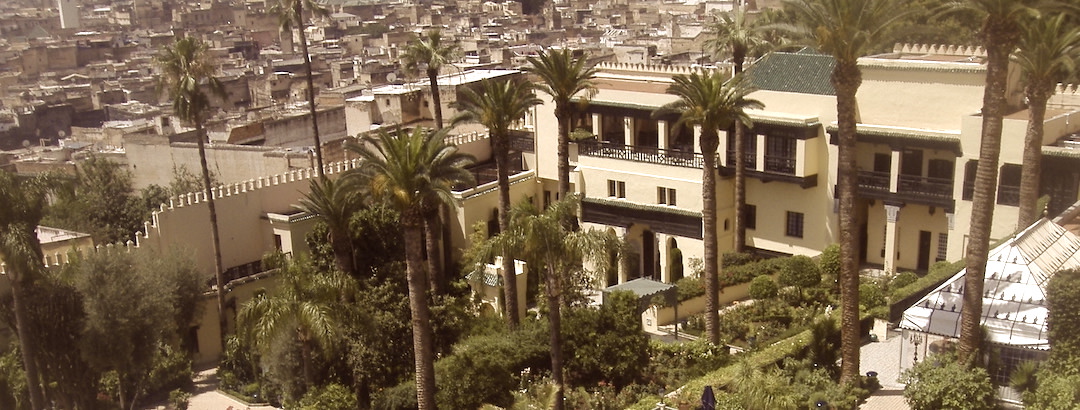All imperial cities of Morocco are hosts to amazing palaces. However, the palaces and riads of Fez are certainly the most impressive.
Hundreds of magnificent properties remain hidden behind the thick and high walls of the narrow medina alleys.
ABANDONED OR SQUATTED PALACES AND RIADS OF FEZ
The largest palaces and riads of Fez are to be found in the narrow streets of the districts of Douh, Zerbatana and Ziat. They date back to the 19th and early 20th centuries.
Mayfez, formerly a riad owned by the Tazi family, is one of them. Learn more about Mayfez story.
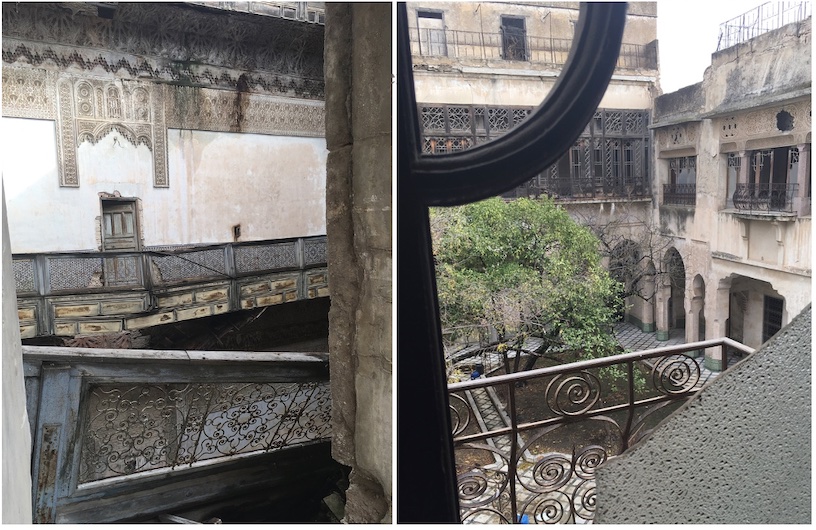
The heirs of these illustrious noble or merchants’ families have abandoned the place long ago, to migrate to more promising destinations.
Some homes are totally abandoned, while others may still be inhabited, or more precisely squatted by poor relatives. The current occupants were often born out of secret or shameful affaires, which gives them a certain legitimacy to occupy the premises.
Many of them would dream of moving out of their squats to settle in council estate buildings. A wish that may seem crazy, but that I can somehow understand after having myself undergone the hassle of refurbishment.
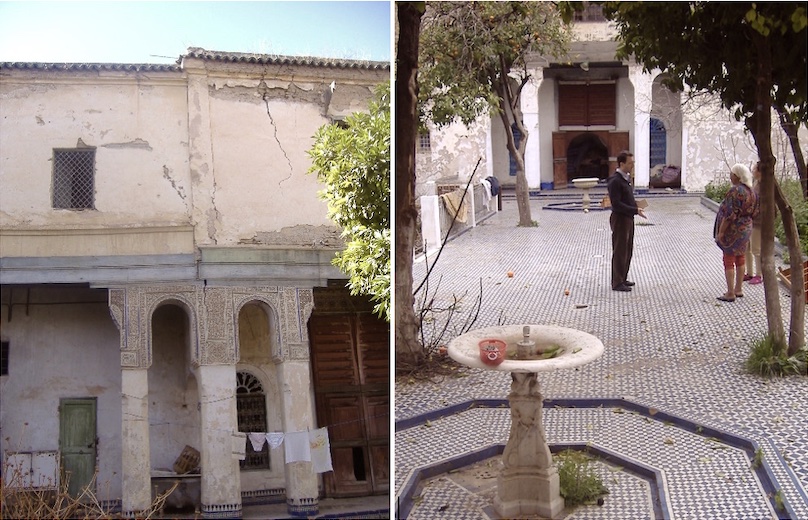
Besides the squatters, the high number of heirs as well as family feuds, end up in making sales, simply, impossible. For example, the number of heirs to the Glaoui Palace is estimated at more than three hundred!
Despite everything, the past greatness remains palpable, even though some palaces and riads are highly damaged today. Therefore, it can, unfortunately, be feared that these Palaces and Riads may definitely disappear.
PALACE, RIAD OR DAR?
To find out more about the different architectural types, I invite you to read our article dedicated to Living a in a Riad.
THE MNEBI PALACE, THE MOST VISITED RIAD OF FEZ
The Mnebi Palace is part of the usual tourist tour of the medina of Fez.
Located in Talaâ Sghira, now operated as a restaurant, it was, during the protectorate’s time, the residence of Marshal Lyautey.
It’s a beautiful example of traditional Arabo-Andalusian architecture. Yet, I find it soulless, and deprived of emotion.
THE GLAOUI PALACE, ONE OF THE LARGEST PALACE AND RIADS OF FEZ
The Glaoui Palace located in the Ziat district, is huge. However, with its 13,000 m2 it is only the second largest Palace in Fez. In terms of surface area, it ranks far behind the Mokri Palace’s 20,000m2.
Yet, the Glaoui’s main patio could have accommodated three, if not four tennis courts. The palace also displays no less than twelve houses and annexes.
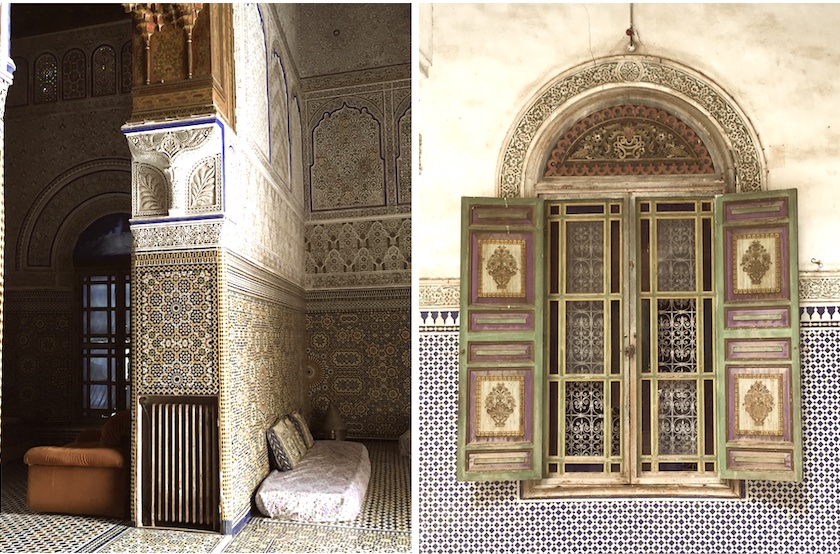
History of Glaoui Palace, one of the must see palaces and riad of Fez
Towards the end of the 19th century, Thami el Glaoui became one of the most powerful members of the family. His powzer was such that he was considered as the strongman of southern Morocco under the domination of the French protectorate, in the 20th century. After Morocco’s independence in 1956, Thami El Glaoui, too close to the French, fell out of favor. His property was seized, his palaces abandoned, but later given back to the family.
The legend surrounding the Palace
It is said that the garages of the palace still accommodate an old Rolls Royce, once gift from Churchill or Elisabeth II, I don’t remember.
Due to constructions around the palace in the mid 20th century, the car is stuck there forever. I have never been able to visit these garages, nor the gardens, and do not know of anyone who could have been so fortunate.
This Rolls Royce will therefore remain a legend, unless you find the arguments to convince the current Palace keeper to open the garages for you … If you succeed, let us know, we are curious …
What to see at Glaoui Palace?
In addition to an art deco bathroom still in its original condition and an absolutely fascinating period kitchen, you can admire Abdelkader’s paintings.
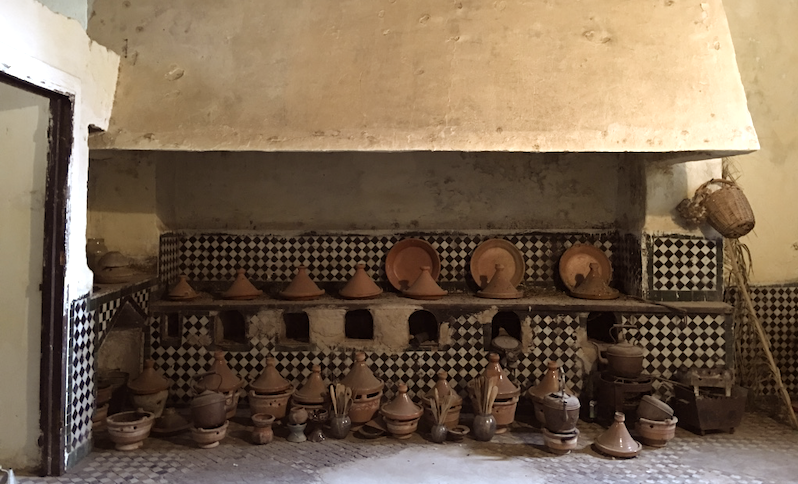
Indeed, the Glaoui Palace is today guarded by a pointillist painter, who exhibits in the salons of the central patio. This gives the Palais the charm of an artist squat, which is, actually, quite pleasant.
Besides, I really like Abdelkader’s both modern and authentic style. I seem to find in him that little something that makes the difference and makes him an artist worthy of the name.
The Glaoui Palace is unfortunately very deteriorated, which is sad to see. However, its splendor remains clearly palpable, providing some kind of nostalgia.
In my opinion, it is a must see.
THE MOKRI PALACE: THE ULTIMATE PALACE & RIADS OF FEZ
In much better condition, the grand Mokri Palace from Ziat is a short walk from the Glaoui Palace. A mix between the splendor of Moorish art and the best of European luxury knowhow.
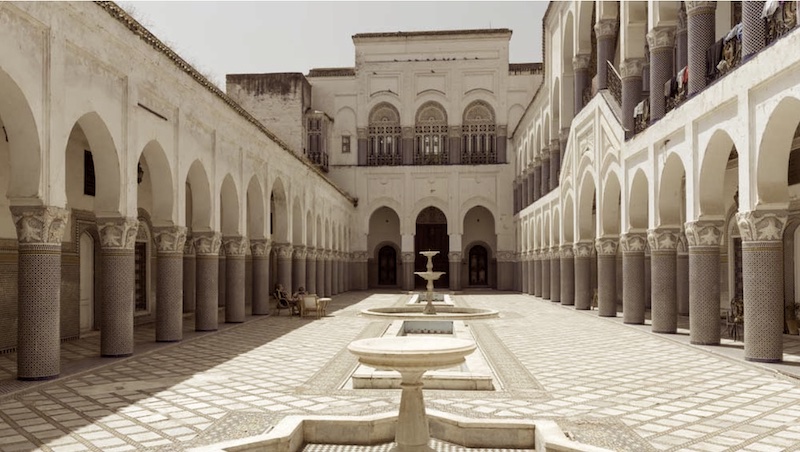
The Mokri, an influential family
There are several Palaces or Riads in the medina of Fez named after the Mokri family. Infact, this illustrious family of Vizier liked to live in the medina. You can find a few lines on the history of the Mokri in the Moroccan magazine Zamane.
As incredible as it may seem, all the family’s estate located in the Fez medina are interconnected by miles of underground tunnels. These were indented to allow the family to move from place to the other without being seen.
The original Palace of the Vizier can no longer be visited, since it has been sold more than fifteen years ago for a hotel project that never came to light.
However, the grand Mokri Palace which is the largest property in the medina, occupying more than 20,000 m2, can be visited on request. Yet, the Mokri Palace is not part of the conventional visits. However, the El Mokri family reopened the doors of the Palace to initiated visitors. Youssef El Mokri, the Vizier’s great-grandson guides a fascinating tour, full of history, stories and anecdotes.
Exceptional architecture
Along with the Ababou Palace, the great Mokri Palace is one of the places that most touched me.
I am never tired of going back visiting and it is often with a tight throat that I come out. Desperate to witness, after each visit, the never-ending ravages of time over this exceptional building.
Jewel of Moroccan heritage built in the 1910s. It showcases the very best of local craftsmanship and the best of the European luxury knowhow. The ironwork has been made in England, the Art Deco staircase is a pure marvel, the few chandeliers that were not stolen, have been made in Murano, while the Syrian knowhow is on display in the music room.
A money pit for the family
At the Mokri palace, the walls speak of the great men who marked international history and walked the zelliges of the patio and the marble of the living areas.
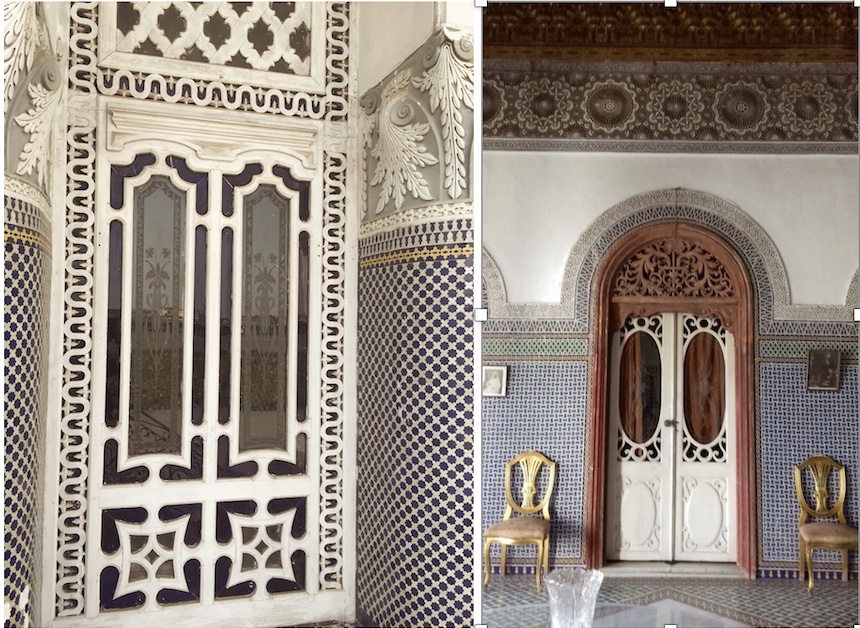
I like to get transported by the emotion provided by the stories so beautifully counted by Youssef.
There in no entrance ticket, but a note will be welcome to help with the maintenance costs of the house.
Needless to say, the maintenance of such an estate – 20,000 m2 of land, of which 6,000 m2 are built – is not easy task. Watering the zelliges to prevent them from exploding in the scorching summer sun, maintaining the woodwork, and much more, require colossal resources.
A residence acclaimed by the Seventh Art
To do so, the El Mokri family hosts receptions and film shoots. “Jewel of the Nile” with Michael Douglas, “The Man Who Worth Billions” by Michel Boisrond and a few other productions, were partly shot at the Mokri Palace.
The deal is that the film direction restores the parts of the building in which they are interested, and in return, the owners give them the right to use the premises for free.
An arrangement that has the merit of saving the Palace, at least, for the time being.
DAR ABABOU: THE FORGOTTEN PIECE OF THE PALACES AND RIADS OF FEZ
I would like to finish with one of my favorite riads of Fez.
Located a few meters from Mayfez, the palace is closed to the public. However, we sometimes manage to have it opened, for a few dirhams, when the house keeper is around.
The first time I entered the Ababou Palace, I felt so much emotion, it brought tears to my eyes.
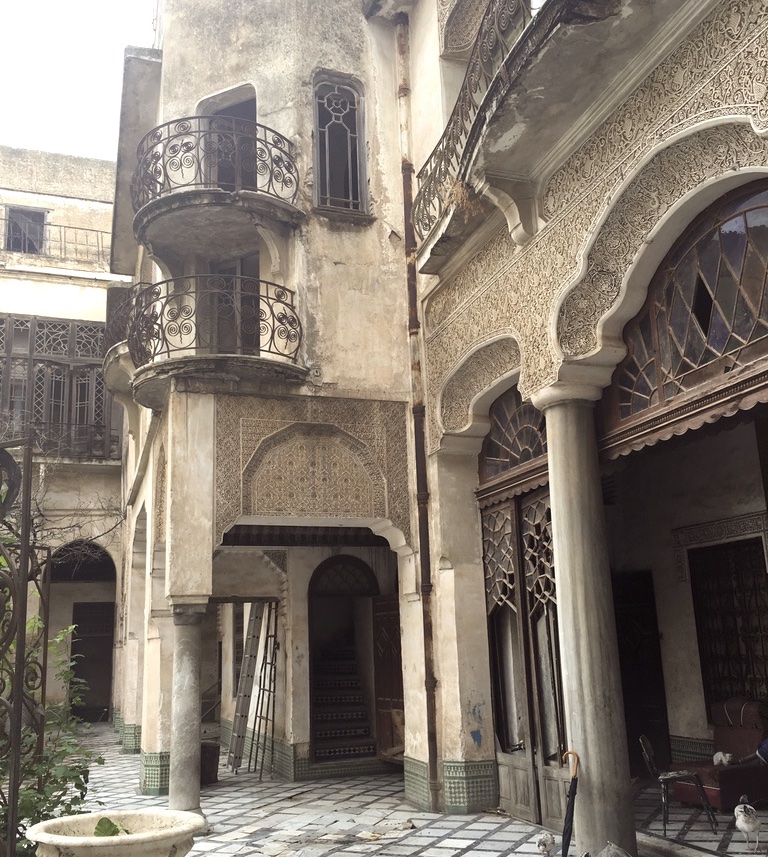
The architecture of the Ababou Palace
Dar Ababou is a blend of Art Nouveau and Arab-Andalusian art unparalleled in what I could ever see in Morocco.
The estate consists in a strangely Europeanized modern wing and a very traditional, superbly crafted Moorish wing. Unfortunately, the latter is considerably damaged.
Gigantic marble columns line the living areas around the modern wing’s patio. It is a wonder how these 7 meters high columns, carved in a single block of marble were carried through the streets of the medina.
Also, Dar Abou’s corbelled balconies are unique in Morocco, as are the variety of the creative wooden window frames. Even more innovative, the sliding windows opening on the patio and on the numerous balconies.
Finally, the delicacy of the carved plaster cannot be compared to any other, except perhaps that of the Medersa Bouanania.
One of the most endangered palaces and riads of Fez
The remains of Dar Ababou’s old conservatory standing on the terrace can be admired from the Mayfez roof top.
When strolling the our terrace, I always spend a minute enjoying a climpse at Dar Ababou. It’s like I have to fill my eyes with its beauty while it’s still standing here.
I have wandered the corridors of that palace so many times that they feel like old friends to me. Yet every year I feel the need to visiting.
Should they read these few lines, I would like the Ababou family, to know how lucky they are to own such a gem. I just want to tell them to cherish it and not let it perish.
So, yes, if I could, I would renovate them all, because they are the living symbol of what man is capable of achieving, but for how long …

